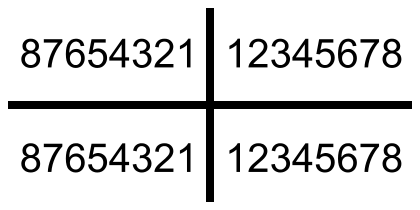Palmer notation
Palmer notation (named after Ohio dentist Dr. Corydon Palmer[1]) is a dental notation used by dentists to associate information to a specific tooth. Also known as the Military System. Although supposedly superseded by the FDI World Dental Federation notation, it overwhelmingly continues to be the preferred method used by orthodontists, dental students and practitioners in the United Kingdom.[2]
It was originally termed the Zsigmondy system after the Hungarian dentist Adolf Zsigmondy who developed the idea in 1861, using a Zsigmondy cross to record quadrants of tooth positions.[3] Adult teeth were numbered 1 to 8, and the child primary dentition (also called deciduous, milk or baby teeth) were depicted with a quadrant grid using Roman numerals I, II, III, IV, V to number the teeth from the midline. Palmer changed this to A, B, C, D, E. This makes it less confusing and less prone to errors in interpretation.
The Palmer notation consists of a symbol (┘└ ┐┌) designating in which quadrant the tooth is found and a number indicating the position from the midline. Adult teeth are numbered 1 to 8, with deciduous (baby) teeth indicated by a letter A to E. Hence the left and right maxillary central incisor would have the same number, "1", but the right one would have the symbol, "┘", underneath it, while the left one would have, "└".

Table of codes
Orientation of the chart is traditionally "dentist's view", i.e. patient's right corresponds to notation chart left. The designations "left" and "right" on the chart, however, nonetheless correspond to the patient's left and right, respectively.
| Permanent Dentition | |||||||||||||||
|---|---|---|---|---|---|---|---|---|---|---|---|---|---|---|---|
| upper right | upper left | ||||||||||||||
| 8┘ | 7┘ | 6┘ | 5┘ | 4┘ | 3┘ | 2┘ | 1┘ | └1 | └2 | └3 | └4 | └5 | └6 | └7 | └8 |
| 8┐ | 7┐ | 6┐ | 5┐ | 4┐ | 3┐ | 2┐ | 1┐ | ┌1 | ┌2 | ┌3 | ┌4 | ┌5 | ┌6 | ┌7 | ┌8 |
| lower right | lower left | ||||||||||||||
| Primary Dentition | |||||||||||||||
| upper right | upper left | ||||||||||||||
| E┘ | D┘ | C┘ | B┘ | A┘ | └A | └B | └C | └D | └E | ||||||
| E┐ | D┐ | C┐ | B┐ | A┐ | ┌A | ┌B | ┌C | ┌D | ┌E | ||||||
| lower right | lower left | ||||||||||||||
With the move from written dental notes to electronic records, some difficulty in reproducing the symbols has been encountered.[4] On a standard keyboard 'slash' and 'backslash' may be used as a crude approximation to the symbols with numbers placed before or afterwards; hence 3/ is 3┘ and /5 is ┌5
Daniel Johnson has put together a Palmer Tooth Notation TrueType font called FreePalmer. It can be downloaded: "FreePalmer TrueType Font". It is covered by the GPL 3 license. This font is descended from FreeSans, part of the "Freefont project". A screenshot showing it working in OpenOffice can be seen here: "FreePalmer in OpenOffice". A derivative which enables the grid patterns to be produced that correspond to handwritten Palmer tooth notations is available for download as well "FreePalmerMP7 TrueType Font".
One advantage of Palmer notation is that it can produce a very graphical image, akin to a 'map' of the dentition; tooth transpositions or edentulous spaces can easily be depicted if desired. It would also be feasible to introduce additional alphabetic characters or other symbols, for example to denote supernumerary teeth or bridge pontics, to which a purely numerical method such as the FDI system does not lend itself easily.[4]




Victor Haderup notation (Danish variant)
The Danish dentist Victor Haderup devised a variation of the Palmer notation where the (┘└ ┐┌) symbols are replaced by plus/minus signs, which can either be placed in front or behind the number.[5][6][7] A plus (+) indicates upper position while minus (−) indicates lower. When the sign is in front of the number, it indicates left while after it indicates right. For instance −6 indicates the 6th lower left tooth, i.e. first mandibular molar.
See also
- Dental notation
- FDI World Dental Federation notation
- Universal numbering system
External links
References
- Bunn S (19 May 2006). "Tooth Numbering". Retrieved 2010-04-21.
Footnotes
- Edward F. Harris (2005). "Tooth-Coding Systems in the Clinical Dental Setting" (PDF). Dental Anthropology. 18 (2): 44. ISSN 1096-9411. Archived from the original (PDF) on 2012-01-06.
- Blinkhorn A, Choi C, Paget H (1998). "An investigon into the use of the FDI tooth notation system by dental schools in the UK". Eur J Dent Educ. 2 (1): 39–41. doi:10.1111/j.1600-0579.1998.tb00034.x. PMID 9588962.
- Huszár G (1989). "[The role of the life and works of Adolf Zsigmondy and Ottó Zsigmondy in the history of dentistry]". Fogorv Sz. 82 (12): 357–63. PMID 2689240.
- Ferguson J (2005). "The Palmer notation system and its use with personal computer applications". British Dental Journal. 198 (9): 551–3. doi:10.1038/sj.bdj.4812303. PMID 15895048.
- "Introduction to Dental Anatomy (Dental Anatomy, Physiology and Occlusion) Part 1".
- Havale, R.; Sheetal, B. S.; Patil, R.; Hemant Kumar, R.; Anegundi, R. T.; Inushekar, K. R. (2015-06-01). "Dental notation for primary teeth: a review and suggestion of a novel system". European Journal of Paediatric Dentistry. 16 (2): 163–166. ISSN 1591-996X. PMID 26147826.
- "Victor Haderup". Den Store Danske (in Danish). Gyldendal.